Movie Review – Grindhouse Features: Planet Terror & Death Proof
In such a regard do I hold auteur filmmakers Robert Rodriguez and Quentin Tarantino, I was pleased to hear them announce their own homage of sorts to pulp cinema of the seventies and early eighties. Their plan was ambitious to say the least, by the Hollywood machine standards of today. Make two feature length films, in the style of classic pulp horror/exploitation/violent movie that littered early VHS rental stores, play them back to back in a cinema and only charge the audience admission for one film? The marketing gurus in the studio backlots must have been aghast. One can only imagine.
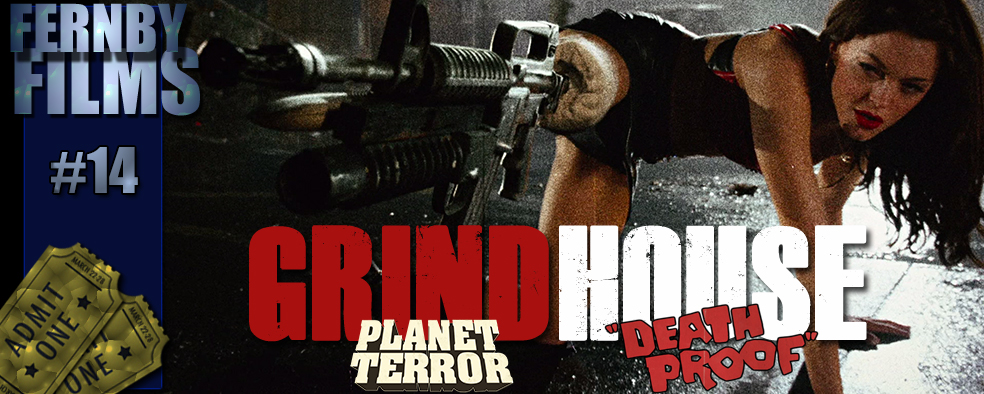
Self reverential films are something I love: films about films, films that play with the medium to great effect (such as the old Smell-o-Vision and original 3D stuff) plus any film that pays homage to other films is always a hoot. Steve Martins’ opus Dead Men Don’t Wear Plaid, Steve Oederkerk’s awful Kung Pow: Enter The Fist (which in itself was an homage of sorts to Woody Allen’s What’s Up Tiger Lily? and the art of re-dubbing old films) and even the Australian effort Hercules Returns are all examples that, while they may vary in their success, have certain elements that no matter the content, are always humorous.
In such a regard do I hold auteur filmmakers Robert Rodriguez and Quentin Tarantino, I was pleased to hear them announce their own homage of sorts to pulp cinema of the seventies and early eighties. Their plan was ambitious to say the least, by the Hollywood machine standards of today. Make two feature length films, in the style of classic pulp horror/exploitation/violent movie that littered early VHS rental stores, play them back to back in a cinema and only charge the audience admission for one film? The marketing gurus in the studio backlots must have been aghast. One can only imagine.
Of course, if anybody would be able to bring this idea to fruition and any kind of success, Rodriguez and Tarantino would. Both filmmakers are highly regarded among fans of cinema, if not the Hollywood machine, for creating a renaissance of sorts within the industry during the nineties. Pulp Fiction, the breakout hit following on from Reservoir Dogs, left Tarantino nowhere to go but up. Rodriguez, who scored big time with El Mariachi, followed that up with his next major hit Desperado (in which he essentially told the same film as El Mariachi with a larger budget) and the pair were overnight film celebrities. They had the pick of any project they wanted to do, and since they were independent from the major studios, they have pretty much had their own way ever since.
When Rodriguez made the kid-friendly Spy Kids (and it’s ever-diminishing quality of inevitable sequels) he gained a new legion of fans. When Tarantino made Jackie Brown, most critics thought his career had stalled before it had begun. Personally, I liked Jackie Brown, but I could see why some called it flawed and certainly not in the same caliber of his earlier work. Vastly different directorial styles meant that at times, both filmmakers were working at alternate ends of the spectrum; yet somehow they both recognized within each other some kind of kindred spirit. When Rodriguez made the excellent (but exceptionally graphic) Sin City, Tarantino “guest directed” a scene for the film. I don’t ever recall Rodriguez returning the favor, but no doubt Four Rooms is as close as the two ever got to sharing a directorial byline.
Tarantino has gone on record as stating that he is interested in re-inventing some of the classic genre films of ages gone. His Kill Bill duology in particular managed to significantly reinvent the Hong Kong chop-socky action films of the seventies and eighties, with a splash of samurai as well. But instead of just a plain ripoff, he intended to actually make a decent film of it, and the two films consequently rocked the worlds socks off. So, when both he and Rodriguez set themselves up to take on the exploitation films of the same period, complete with ridiculously lousy trailers and bad grammar, you can bet that it’s going to be a fun… perhaps even interesting….. time at the movies.
So what is Grindhouse cinema? Where does the term originate? Well, many have said that it came about during the sexual liberation of the late sixties, when cinemas began showing fare that was considered a little risque or taboo for mainstream audiences. Usually filled with sex (often explicit) and violence (often more explicit) and other such nasty material, B-movie studios and C-Movie studios began to crank these schlocky turds out by the handful. Of course, they were the sorts of films teenage boys would go to the cinema to revel in, lapping up the blood and gore, the titillation of the naked female form and the amazingly bad makeup effects on all the vampire/slasher/sci-fi movies churned out in a week. Tarantino explains it better on the Planet Terror DVD better than I could, so I am really only paraphrasing his words. Not only were the films shockingly bad, the cinemas they played in were hardly world class. And oftentimes, they would only strike a dozen or so prints of the film, meaning that as the prints toured the country, they began to wear out, and so by the end of a film’s theatrical run, the print was practically unwatchable: this really only heightened the coolness of most of these rubbish films, as it gave them a style all their own.
Hence, when it came time to make these films, both directors gave them the faded, filthy look of the way they might have looked had they played in a true grindhouse cinema, complete with faded looks, burn marks, dirt and grime and even missing reels. The bad trailers at the commencement of the films (they played as a duo in cinemas, although being released on separate DVD’s here) are included, as well as the old “here’s a prevue of our coming attractions” (sic) title cards as the films began to roll. So if you didn’t get to see these films in the cinema, and watch them instead on DVD, don’t be surprised to see these films look they way they do: they were filmed that way. Its the way they were meant to be experienced. And its such a retro look, you can sit back and think about all those lousy VHS copies of b-grade films you tried to hire from the local video store when you were under age and smile.
So what about the films themselves?

– Planet Terror – Summary –
Director : Robert Rodriguez
Cast : Josh Brolin, Rosario Dawson, Jeff Fahey, Michael Biehn, Bruce Willis, Stacey Ferguson
Censorship Rating : MA 15+
Target Audience : Horror, action, thriller, pulp.
Length : 90 minutes
Synopsis: When a horrifying army experiment results in the zombification of a small town, one small group of survivors must fight to escape certain death and destruction, in the most bloody and violent way possible.
Review : Wonderfully pulpy film from Rodriguez, a violent, brutal (and hilarious) horror-comedy with all the glorious ineptitude of a B-movie as trashy as anything Hollywood has ever produced.
Horror films that begin with excessive violence and bloody gunshots are never really that effective, at least, to me. I prefer the slow burn, the build-up of tension before the blood runs free. Zombie movies typify this in most regards: it takes a while for the real horror to kick in, although in recent times, that is not always the norm.
Planet Terror breaks the mould, rebuilds the mould again and smashes that all over the ground. This movie is seriously cool, and utterly clichéd: just the way it should be. You even have the gratuitous cameo from the current pop star sensation; in this case, Fergie from The Black Eyed Peas [see image below]. You have the super-splattery blood effect when somebody gets shot (similar in tone to the graphic Kill Bill House Of Blue Leaves scene) and plenty of skin-peeling, limb dismembering puss-filled fun and frivolity. The rampant genre homage’s just kept on coming for the entire length of the film, and this, coupled with the snappy script and great performances (in keeping with the schlocky tone, not one of the cast ever gave less than their best!) plus some outrageous plot twists, Planet Terror is an exercise in how to make a zombie picture so slick its slides off your brain and out the door like a hooker in a hurry.
To be honest, I didn’t really know what to expect when I fired up the home cinema and DVD player, but I was quickly enthralled by what I got.
The film begins with the awesome trailer from the never-been-made Machete, starring a woefully underused Danny Trejo, whose face always looks like the aftermath of either a car wreck, or too many methamphetamines as a child. the trailer is such a great way to set up the films to follow, you can’t help but smile and laugh at the gratuitous-ness of it all. Trejo treats this small snippet of film time with the respect it demands, and, to be honest, you can’t help but wonder what kind of film Machete would have been had it actually been a film. The top image, with Trejo on a motorbike with a chaingun and a massive fireball behind him, is indicative of the style of the trailer.
[Edit: after this review was written, it was discovered that Machete was indeed being turned into a full length feature. D’oh!]
Then the film proper gets underway, and it’s a gangbuster. We see Rose Byrne as Cherry Darling, a go-go dancer looking for a better life. Same old same old, apparently. Although this time, when the science experiment at the nearby Army Base (of course) goes awry, and things turn to gravy, the script is thrown out the window and everybody starts having a grand old time. We see former Lawnmower Man Jeff Fahey playing a country hick so well you’d barely recognize him. We see Michael Biehn in a film that’s not directed by Michael Bay or James Cameron, and he’s actually watchable. We see the rock solid Bruce Willis chewing the scenery like so many wizened actors before him, creating something out of nothing.
Throw in Marley Shelton and Josh Brolin, both of whom do an admirable job keeping a straight face (Brolin especially, dealing with testicular trauma and a puss-filled tongue… you’ll know it when you see it!) throughout, and so many plot twists that your head spins trying to keep up with it all, and you have yourself a Class A Grade Z Zombie Film. That is, the best Worst Zombie Film ever made. And just when you think “it can’t get any more crazy than this, right?”, along comes something else to make you realise that George Lucas is a cinematic hack who squatted over his fans when he made those prequels and called them Star Wars. Did I mention the puss-filled tongue? Of course I did.
When the Army Base turns into the set of The Wild Bunch and things go pear shaped, a mysterious gas infects people and turns them into zombies, roaming out across the land, in turn infecting others and even more others, until your classic group-of-disparate-but-solid rogues and loners band together in a diner/outhouse/farmhouse/apartment to thwart the forces of evil and blow lots of bad guys apart. The form of violence in this film is graphic, but stylized to the point where it’s almost balletic. In the same way that John Woo’s early films are so well choreographed action-wise, they look sublime and feel soft and smooth as silk, so to does the zombie version of the same thing here. It’s all clichéd, but done with one’s non-puss-filled tongue firmly in one’s cheek. And it’s glorious.
Look, Planet Terror will never win an award, for anything, but it is entertaining to a degree I thought had been lost from modern films. Call me cynical, but there is most certainly a place for genre films, of any kind, to be lauded or lambasted by the masses. Critics always hate this kind of stuff, because I think they see horror, rom-com, zombie pictures as a kind of antithesis of everything film should be about: but they have it wrong. Film, by it’s very nature, is intended as a storytelling tool. And as long as people are interested in seeing boobs, zombies, explosions and gun battles, then films like Planet Terror and those it is imitating will continue to get made.
And if that produces images like the one below, then I, for one, am all for it. Planet Terror is a hell of a good ride.
**********************
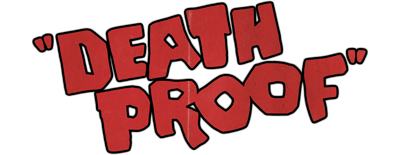
–Death Proof – Summary –
Director : Quentin Tarantino
Cast : Kurt Russell, Sydney Poitier, Rosario Dawson, Zoe Bell, Eli Roth.
Censorship Rating : MA 15+
Target Audience : Action, thriller, horror
Length : 120 minutes
Synopsis: Two groups of unsuspecting women have two different run-in’s with a crazed, homicidal Hollywood stuntman. Car chases ensue.
Review : Well made film is told in two separate parts: the first, talky and typically Tarantino-esque, and the second is a balls-out thrill ride that will leave you breathless.
**********************
This film is a bit of a weird beast. On the one hand, it’s a fantastic example of Tarantino’s ability to write dialogue, and on the other, it concludes with one of the best car chase sequences you’ll see. Action films and dialogue films should never really mix, but here, they do. At one point, you start to wonder where the film is heading, but the sense of menace portrayed on screen by Kurt Russell is palpable.
Things begin innocently enough, in typical Tarantino style, with a group of women off on a road trip to a cabin in the mountains. The image of some naked feet on the dashboard of a car underneath the bold opening credits is as much Tarantino as it is a hearkening back to the early days of modern cinema.
The girls stop off for drinks at a bar, where they quickly run into Russells’ Stuntman Mike, a weird but seemingly jovial ex-stuntman who drives a hotted up, modified vehicle the likes of which hasn’t been seen on screen in years.
The first hour of the film is primarily set with these group of girls in the bar, with plenty of snappy dialogue and themes that you start to wonder if the film is ever going to kick into the promised action. Russell lurks about in the background, and things come to a head when the girls decide to leave. The bravura action setpiece of a car collision is simply staggering to behold, a wonderful cinematic storytelling device that makes you sit up straight and pay attention…. if your attention has been waning.
The cataclysmic event spurs the dramatic impetus of the film into darker, more unknowing territory, something you weren’t quite prepared for. A little like compatriot Rodriguez’s From Dusk Til Dawn, where the story suddenly lurches in a completely different direction half way through, Death Proof reverts quickly back to familiar dialogue driven territory for a while longer, with a complete set of new characters, and then the action kicks in.
And it’s a this point that you realise that Tarantino is quite well versed in cinema lore, and is as adept at conveying the feelings and emotions of different cinematic styles as he is at writing dialogue. The car chase sequence in Death Proof is validation of Tarantino’s mastery of storytelling in different genres and styles, and handling large scale action sequences with a relaxed assurance of somebody whose been there many times before.
Mention must be made, of course, to the appearance of Zoe Bell as the crazy Kiwi stuntwoman who arrives on the scene (accent intact) and proceeds to make the rest of the cast look mediocre by comparison – her stuntwork in the chase scene alone is reason enough to applaud Tarantino for casting her. While she may not be as well versed at acting as her screen buddies, she’s certainly adept at the most amazing stuntwork you’ll see anywhere.
The action is frenetic, fast and well edited, with a thunderously cool soundtrack accompanying it. Bell is in real danger as she slides across the bonnet of the free-wheeling vehicle, her friends (Abbie, played by Rosario Dawson, and Kim, played by Tracie Thoms) screaming out to save her. With Stuntman Mike barreling after them with death on his mind, the tension ratchets up substantially.
The dialogue, while not a bit on par with Tarantino’s earlier work, is still scintillating, although when the tension gets too much, the characters leap out with all the F-words you can muster in a single sentence. Unfortunately, this degenerates what would be real dialogue into a cliché of itself: it’s been a fault of Tarantino’s scriptwriting for a long time that he uses the F-word to lengthen the importance of his dialogue, to try and give added weight to what the characters are saying. Instead, the importance of their words is lost in amongst a plethora of cursing and profanity. Not everybody uses this much profanity all the time.
A key scene with a horribly out of place Eli Roth (director of such horror-fests as Hostel and Cabin Fever) as a randy, beer swilling lad out to get laid is somewhat out of place within the context of the film, and does nothing at all to further the plot. The somewhat wobbly opening car dialogue scene is a little long, and the audience, by the time it ends, is starting to wonder what the point of it all is; that said, at times, the script sparkles.
Death Proof manages to be somewhat comedic, enthralling and at moments, truly scary, as it rattles along in the true tradition of the films it is trying to emulate. Tarantino appears to be unstoppable in his ability to not only mimic, but altogether redefine the genre’s he’s trying to invigorate. While as pulpy as Rodriguez’s earlier effort in Planet Terror, Death Proof is not quite as obsequious and more traditionally made; yet still retains the tongue in cheek sensibility of the Grindhouse label.

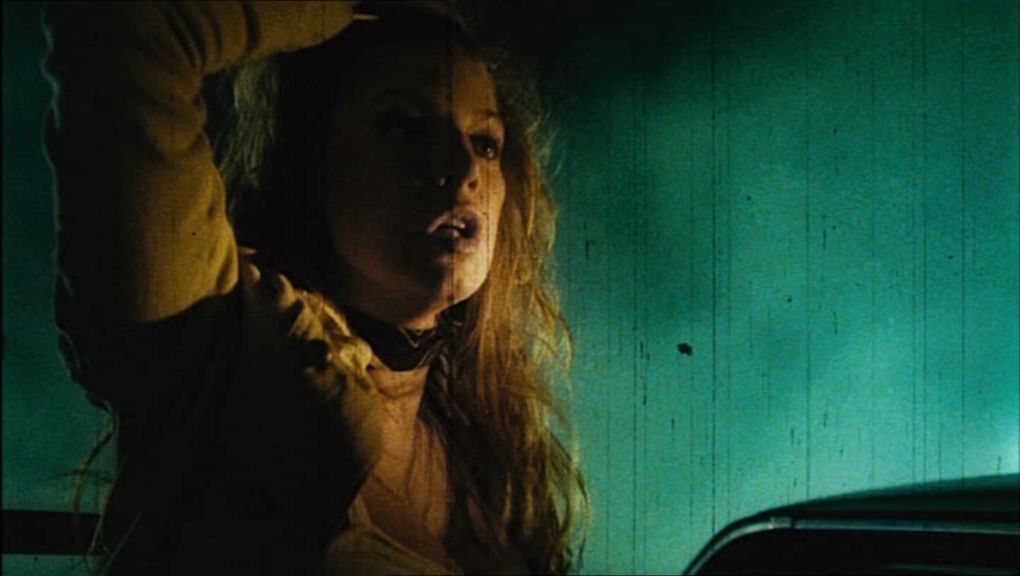
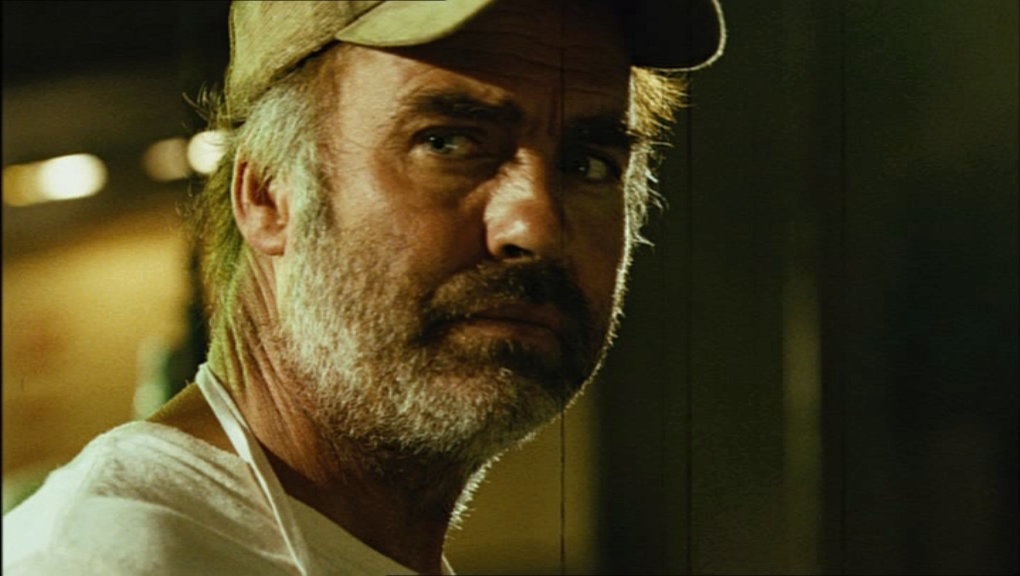


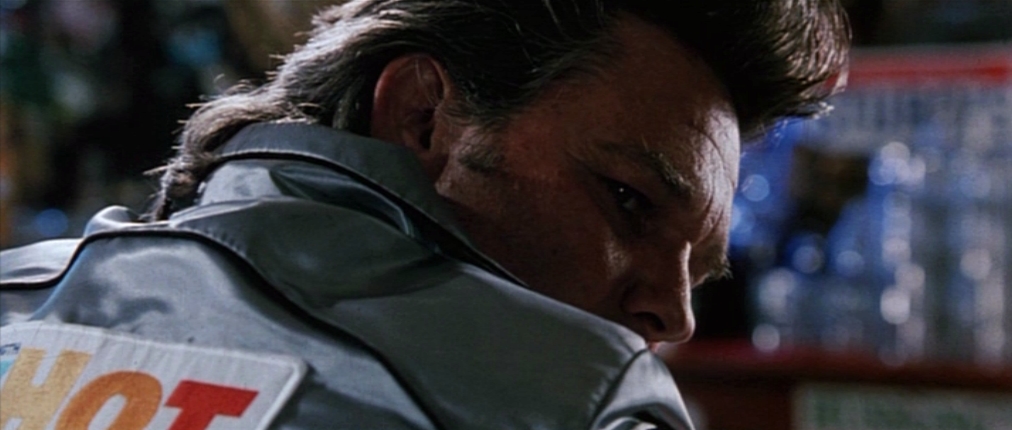
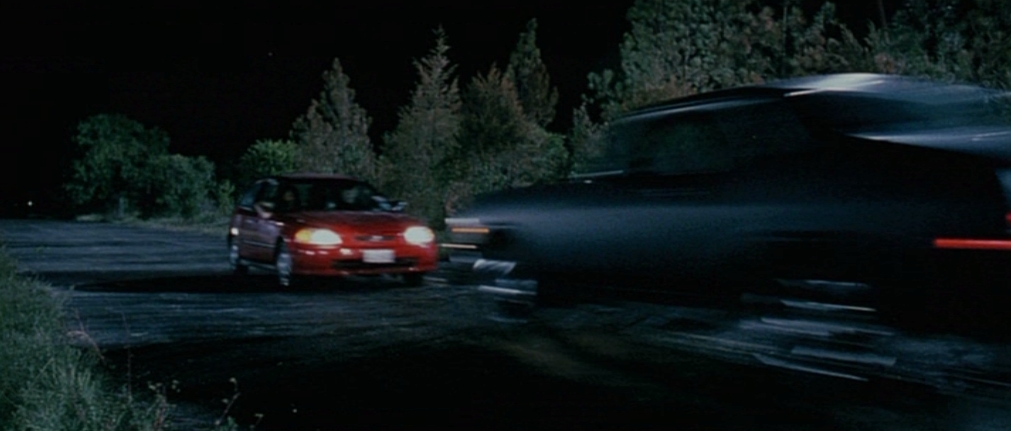

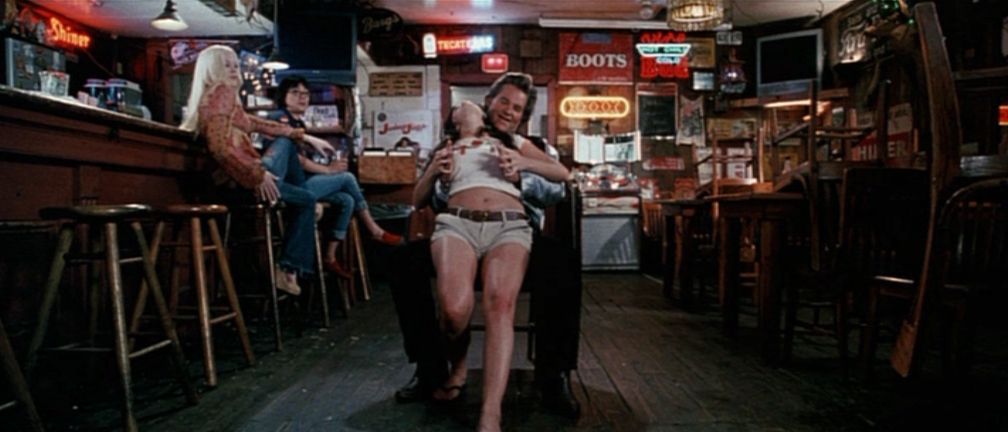
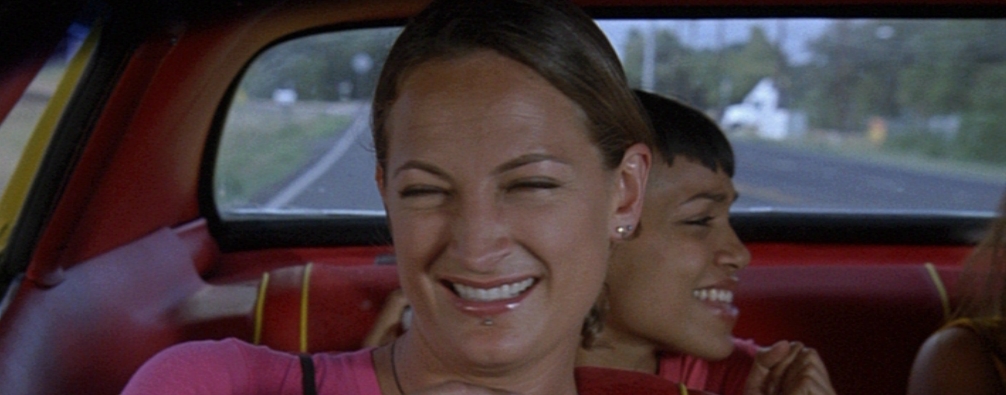
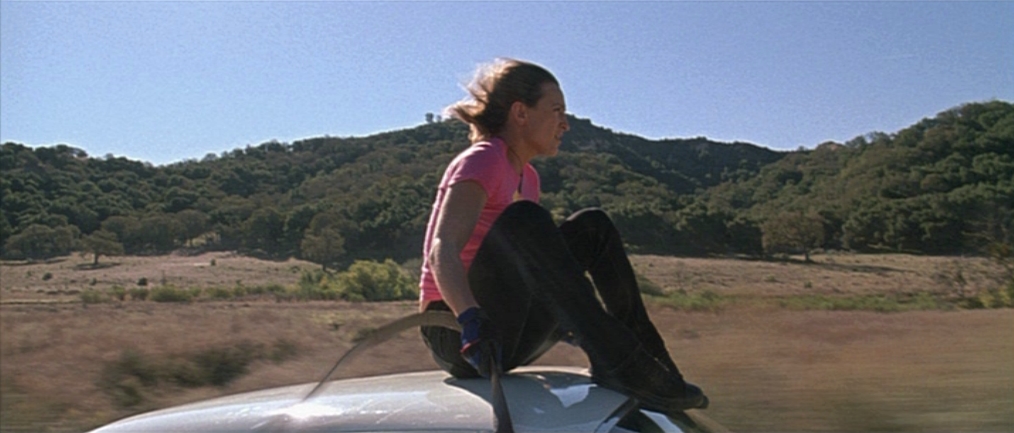
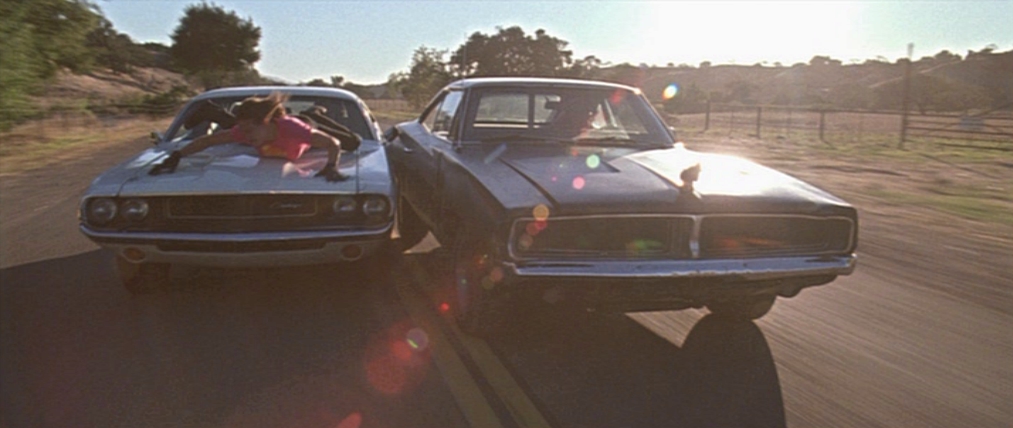











Tarantino’s legendary style.
My recent post Trinity RG – Download Torrents